D?m?si P., Nehaniv C.L. Algebraic Theory of Automata Networks. An Introduction
Подождите немного. Документ загружается.

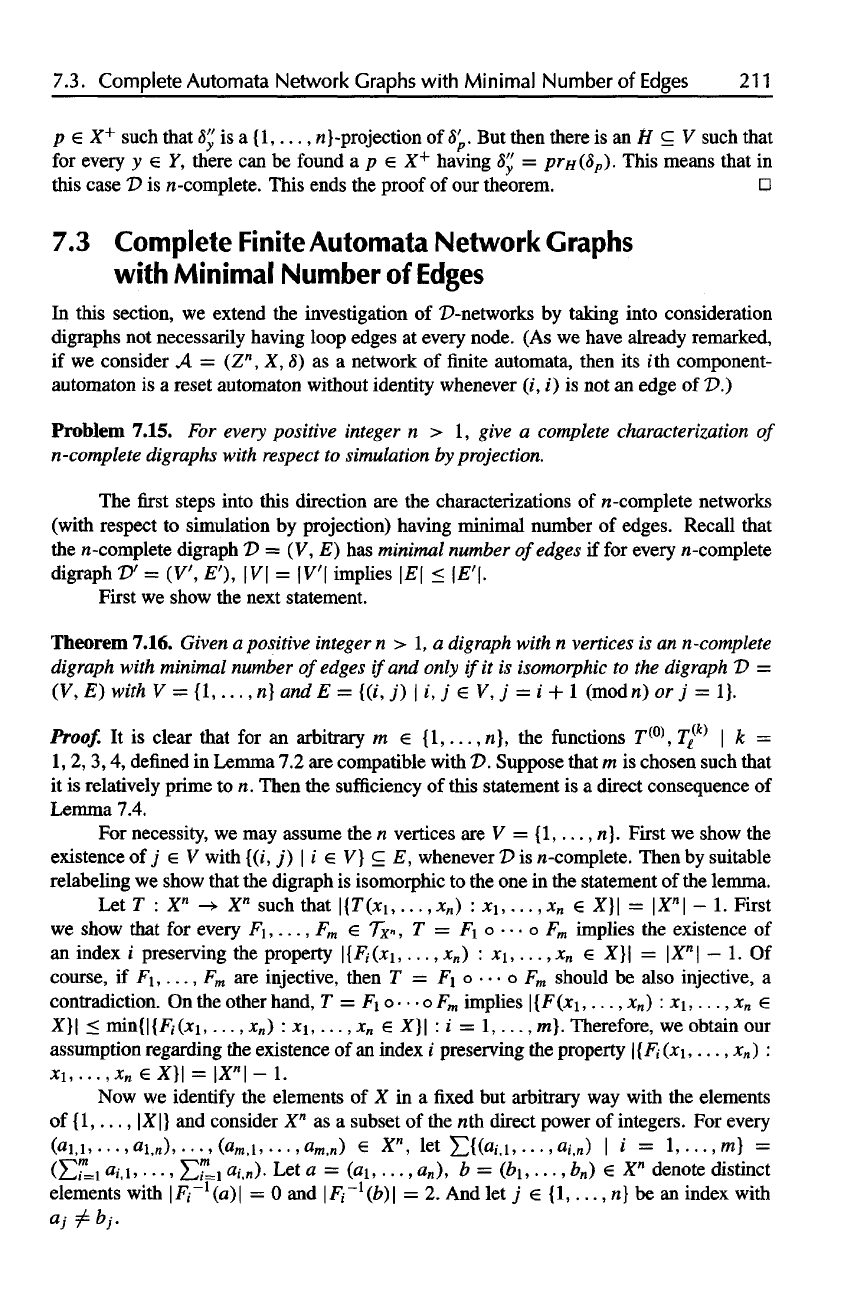
7.3. Complete Automata Network Graphs
with
Minimal
Number
of
Edges
211
p
€ X
+
such that
Sy
is a
{1,...,
n}-projection
of '
p
. But
then there
is an H c V
such that
for
every
y € 7,
there
can be
found
a p G X
+
having
Sy
=
prn(
p
).
This means that
in
this case
D is
n-complete. This ends
the
proof
of our
theorem.
7.3
Complete Finite Automata
Network
Graphs
with
Minimal
Number
of
Edges
In
this section,
we
extend
the
investigation
of
P-networks
by
taking into consideration
digraphs
not
necessarily having loop edges
at
every node.
(As we
have already remarked,
if
we
consider
A =
(Z
n
,
X, 5) as a
network
of finite
automata, then
its ith
component-
automaton
is a
reset
automaton without identity whenever
(i, i) is not an
edge
of .)
Problem
7.15.
For
every
positive
integer
n > 1,
give
a
complete
characterization
of
n-complete
digraphs
with
respect
to
simulation
by
projection.
The first
steps into this direction
are the
characterizations
of
n-complete networks
(with
respect
to
simulation
by
projection) having minimal number
of
edges. Recall that
the
n-complete digraph
D = (V, E) has
minimal number
of
edges
if for
every n-complete
digraph
D'
= (V,
E'),
\V\ =
\V'\ implies
\E\ <
\E'\.
First
we
show
the
next statement.
Theorem 7.16. Given
a
positive
integer
n > 1, a
digraph
with
n
vertices
is an
n-complete
digraph
with minimal number
of
edges
if
and
only
if
it is
isomorphic
to the
digraph
V =
(V,
E)
with
V =
{1,...,
n} and E =
{(i,
j) \ i, j eVJ =i + l
(modn)
or j = 1}.
Proof.
It is
clear that
for an
arbitrary
m e
{1,...,
n}, the
functions
T
(0)
,
T
k)
\ k =
1,
2,
3,4,
defined
in
Lemma
7.2 are
compatible with
Z>.
Suppose that
m is
chosen such that
it
is
relatively prime
to n.
Then
the
sufficiency
of
this statement
is a
direct consequence
of
Lemma 7.4.
For
necessity,
we may
assume
the n
vertices
are V =
{1,...,«}. First
we
show
the
existence
of j e V
with {(i,
j) \ i e V} c E,
whenever
D is
n-complete. Then
by
suitable
relabeling
we
show that
the
digraph
is
isomorphic
to the one in the
statement
of the
lemma.
Let
T : X
n
-> X
n
such that \{T(xi,
...,*„):
*i,
...,*„€
X}| =
|X"|
- 1.
First
we
show that
for
every
F\,...,
F
m
e
7x«,
T = F\ o • • • o F
m
implies
the
existence
of
an
index
i
preserving
the
property
\{Fi(x\,...,
x
n
) :
x\,...,x
n
€ X}\ =
\X
n
\
— 1. Of
course,
if
FI
,...,
F
m
are
injective, then
T = F\ o • • • o F
m
should
be
also injective,
a
contradiction.
On the
other hand,
T = F\ o • • • o F
m
implies
|
{F(jci,...,
x
n
)
:x\,...,x
n
€
X}\
<
min{|{F,
(*i,...,
#
M
) :
x\,...
,x
n
€ X}\ : i =
1,...,
m}.
Therefore,
we
obtain
our
assumption regarding
the
existence
of an
index
i
preserving
the
property
|
[F,\(xi,...,
x
n
) :
Xl
,...,x
n
eX}\
=
\X
n
\-l.
Now
we
identify
the
elements
of X in a fixed but
arbitrary
way
with
the
elements
of
(1,...,
|X|)
and
consider
X
n
as a
subset
of the nth
direct power
of
integers.
For
every
(ai
t
i,...,ai
tn
),...,(a
mi
i,...,a
m
,
n
)
€ X
n
, let
£{(a
u
,
...,a
(
>)
| i =
l,...,m}
=
(E"=i
a
u> • • •'
ET=i
ai,n)•
Let a =
(fli,...,
a
B
),
b =
(bi,...,b
n
)eX
n
denote
distinct
elements with
IF,"
1
^)!
= 0 and
\F
-1l
(b)\
= 2. And let j e
{1,...,
n} be an
index with

212
Chapter
7.
Finite State-Homogeneous
and
Asynchronous Automata
Networks
We
prove that
|
X
\
does
not
divide
prj
(£{F,
(xi,
...,x
n
)
: x\, ... ,x
n
e
X})
.
Indeed,
then
/>r,(£{F
(
-
(*!,...,*„)
: *
lt
. . . ,x
n
e X}) =
prj(^{(xi,
. . .
,*„)
:
x\,...,x
n
e
X})
+
bj
-
cij)
=
IX^KESo"
1
*) + fy ~
a
J-
of
course,
by
this equality
we
have that
|X|
does
not
divide
/>o(E{F,(*i,
...,*„):*!,...,*„€
X}).
Suppose that
for
every
j eV
there exists
an i e V
with
(/, j) £ E.
Consider
the set V
x
of
all
functions
of the
form
X
n
-> X
n
which
are
compatible
with
T>.
Now we
show that
for
every
F €
£>x,
|X|
divides
/>/v(£{F(*i,
. . . , x
n
) : *i, . . . , x
n
e
X}), implying
F, £ V
x
.
By
F e I?x we
have that
for
an
appropriate
i e
{!,...,«},
prj(F(x\,
...,
*„))
=
prj(F(xi,
..., xt-i,
x'
t
,
xt+i,
...,
*„))
((XL
...,x
n
)
e
X
n
,x'
t
e X, £ = j is
allowed).
Therefore,
for an
arbitrary
fixed c e X,
prj(^{F(x\,
. . . , *„) :
x\,...,x
n
€ X}) =
\X\pr
j(£,{F(xi,...,xt-i,
c,xt+i,...,Xn)
: x\, .
..,*/_i,**+i
f
...,*„
€
X}).
But
then
|X|
divides
prj(£[F(x\,
...,x
n
)
:
x\,...,x
n
e X}) for
every
j = 1, . . . , n.
Hence
we
get F, £
Z>x-
Consequently, there exists
a T 6 Tx»
with
T ^
(Px)- This ends
the
proof
of the
existence
of j e V
with {(i,
j) \ i e V] c. E
whenever
T>
is
n-complete.
Then
we are
done
if we can
prove
the
existence
of a
permutation
p : V -> V
with
{(P(0,
PO'))
I
»,
7 e V,
p(j)
=
p(i)
+ 1
(modn)}
c E.
Consider
the
mapping
r
(0)
: X
n
-> X
n
defined
by
r
(0)
(*i,
...,*„)
=
(*„,*!,
. . . , x
n
_
i ) (^i , . . . , x
n
e X) . To
complete
the
proof
of our
theorem,
we
will show
T
(0)
^
T>x
if
there exists
no
such
a
permutation
p.
It
is
also clear that
an
n-complete digraph
P,
having
n
vertices, should
be
strongly
connected. Therefore,
all
vertices have (nonloop) incoming edges. Thus,
by the
minimality
of
\E\,
we get \E \
{(i,
j) : i e V}\ = n — 1.
Simultaneously,
the
strongly connectivity
of
D
implies
{j} x (V \
{;})
n E 0
(where
7 € V
with {(/,
;) \ i € V] c. E). On the
other hand,
if
there exists
no
permutation
p
having
the
above discussed property, then
by
the
strong connectivity
of
D,
V x {j} c E, and \E \
{(i,
7) : i e V}\ = n - 1, we can
prove |{y'}
x (V \
{7})
n E\ 2,
implying
the
existence
of two
distinct vertices i'i,
12
6 V
with
{(€,
i
r
) | r = 1, 2, € € V} n E =
{(j,
iO, (7,
i
2
)}.
It is
enough
to
prove that
in
this case
T
(0)
D-
Clearly,
F\ e PX
implies
the
existence
of
functions
/* : X > X, fc =
1,2,
with
pr
ik
(F\(x\,
. . . ,
*„))
=
/*(*/).
Therefore,
the
cardinality
of
{(yi,
y
2
) I y* =
pn
k
(Fi(xi,
...,
x
n
»,
k=l,2,
xi,...,x
n
e
X}
is not
greater than |X|.
In a
similar way,
for
every
F\,
...,F
m
eT>
x
,m
> 1,
there exist
functions
fk : X -> X, fc = 1, 2,
such that pr
ik
(F\
o • • • o
F
m
(x
1
,
. . . ,
*„))
=
fk(prj(F\
o
•
• • o
F
m
_i(*i,
. . . ,
A:
m
))),
implying that
the
cardinality
of
{(yi,
y
2
) I Jk =
/?r
(t
(Fi
o • • • o
F
W
(JCI,
. . . ,
*„)),
A:
= 1, 2,
jci,
. . . , x
n
€ X} is not
greater than
|X|.
On the
other hand,
the
cardinality
of
{(y
lt
y
2
) I y
k
=
pr
ik
(T
(Q)
(x^
...,
x
n
)),
k = 1, 2, *
lt
. . . , x
n
6 X} is
|X|
2
,
yielding
to
T
(0)
^ P
x
- The
proof
is
complete.
Now
we
prove
the
following characterization.
Theorem
7.17.
Given
a
positive
integer
n > 1, T> = (V, F,)
with
V =
{l,...,m},
m > n, is an
n-complete
digraph
with minimal number
of
edges
if
and
only
if
there
exists
a
permutation
p : (1, . . . , m} \-> {I, . . . , m]
such that
E =
{(/?(/),
/>0'))
I
p(0.
p(j)
€
{!,...,«
+ !},
p(j)
= p(i + 1
(modn
+
1))}
U
{(/?(!),
p(r))},
wnere
r € {1, . . . , n + 1},
r ^ 2,
anJ,
moreover,
r
—
2 and n + 1 are
relatively
prime.
31
37
The
case
r = 1 is not
excluded.
Moreover,
if
there
are
more
than
n + I
vertices,
then
all
except
for n + 1
are
isolated.
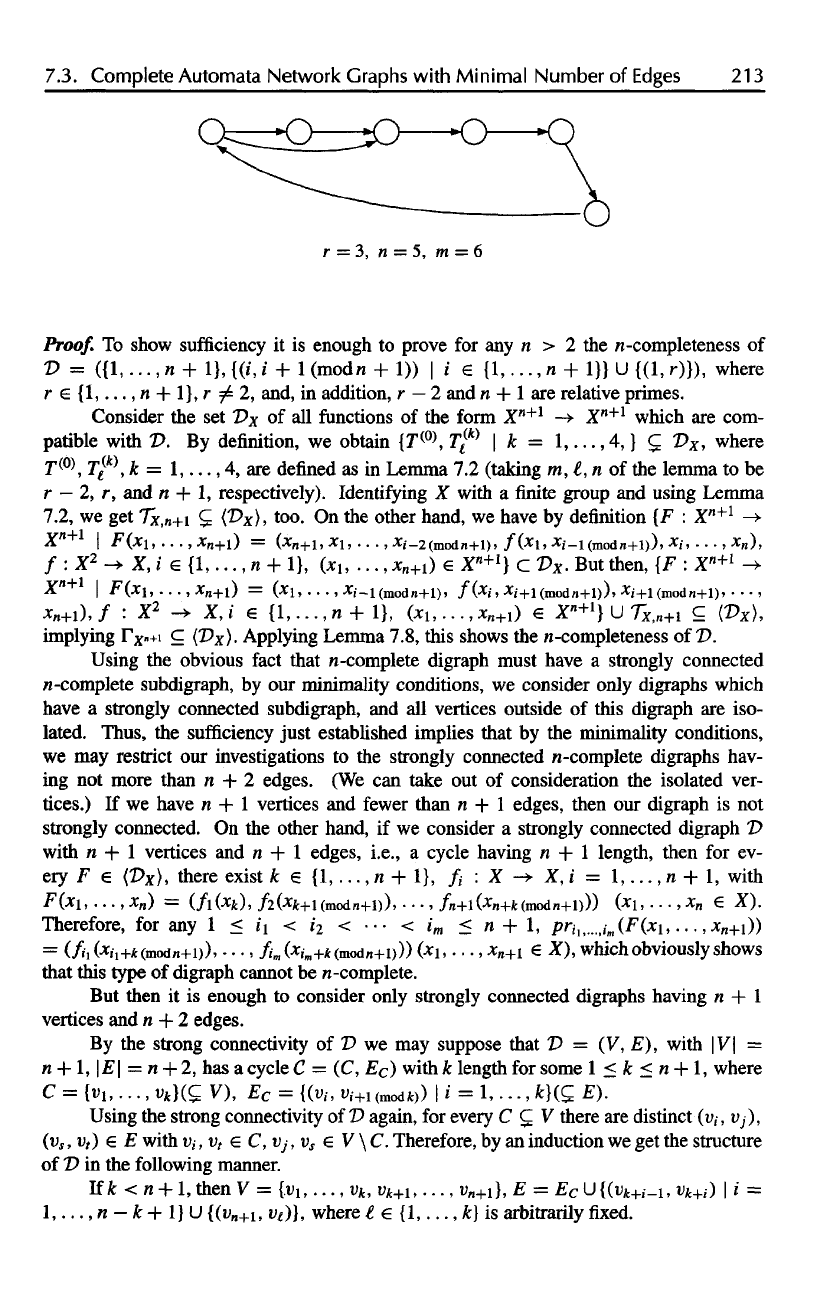
7.3.
Complete Automata Network
Graphs
with
Minimal
Number
of
Edges
213
Proof.
To
show
sufficiency
it is
enough
to
prove
for any n > 2 the
n-completeness
of
V =
({I, ...,«
+ !},
{(i,
i + 1
(modn
+ 1)) | i e {1, . . . , n + 1}} U
{(1, r)}), where
r e {1, . . . , n + 1}, r ^2,
and,
in
addition,
r
—
2 and n + 1 are
relative primes.
Consider
the set Dx of all
functions
of the
form
X
n+l
->
X
n+l
which
are
com-
patible with
£>. By
definition,
we
obtain
{T
(0
\T^
k)
\ k = 1, . . . , 4, } C D
x
,
where
r
(0)
,
j-(
)^
^ _ i
;
. . .
?
4
5
are
defined
as in
Lemma
7.2
(taking
m,t,n
of the
lemma
to be
r
— 2, r, and n + 1,
respectively).
Identifying
X
with
a finite
group
and
using Lemma
7.2,
we get
T
x
,
n
+i
£
(D
x
}, too.
On the
other hand,
we
have
by
definition
(F :
X
n+l
-+
X
n
|
F(XI,
. . . ,
X
n+
i)
=
(x
n+
i,X\,
. . . ,
*i-2(modn+l)»
/(*!» *i-l
(mod
«+!))»
x
i
• • •
>
xn),
f
: X
2
-» X, i € {1, . . . , n + 1},
(*i,
. . . ,
JC
B+
I)
e
X
n+l
}
c
T>X.
But
then,
{F :
X
n+l
-+
X
n+
|
F(XI,
...,
X
n+
i)
=
(*i,
. . . ,
*,-_i
(modn+l)>
f(*i,
*i+l
(mod«+l))>
*i+l
(modn+1),
• • •
»
*,+!),/
: X
2
-> X, i e
{!,...,
n + 1},
(*
lf
. . . ,
x
n+l
)
€
X
n+1
}
U
Ti.,,+1
c
(D
x
),
implying
FX-+I
^
{^x>. Applying Lemma 7.8, this shows
the
n-completeness
of V.
Using
the
obvious
fact
that n-complete digraph must have
a
strongly connected
n-complete subdigraph,
by our
minimality
conditions,
we
consider
only digraphs which
have
a
strongly connected subdigraph,
and all
vertices outside
of
this digraph
are
iso-
lated. Thus,
the
sufficiency
just established implies that
by the
minimality conditions,
we
may
restrict
our
investigations
to the
strongly connected n-complete digraphs hav-
ing
not
more than
n + 2
edges.
(We can
take
out of
consideration
the
isolated ver-
tices.)
If we
have
n + 1
vertices
and
fewer
than
n + 1
edges, then
our
digraph
is not
strongly connected.
On the
other hand,
if we
consider
a
strongly connected digraph
V
with
n + 1
vertices
and n + 1
edges,
i.e.,
a
cycle having
n + 1
length, then
for ev-
ery
F e
(D
x
), there exist
*€{!,...,«
+ !}, /) : X -» X, i = 1, . . . , n + 1,
with
Therefore,
for any 1 < i'i < ii < ••• < i
m
< n + 1,
pr,-
1)
...
(
/
Bi
(F(jci,
. . . ,
x
n+
\))
=
(//,(*,-,+*
(ni
od«+i)),
• • • ' A,
(*i*+*
(modn+i)))
(*i,...,
*»+i
e X),
which obviously shows
that
this type
of
digraph cannot
be
n-complete.
But
then
it is
enough
to
consider only strongly connected digraphs having
n + 1
vertices
and n + 2
edges.
By
the
strong connectivity
of
T>
we may
suppose that
T>
= (V, E),
with
|V| =
n
+
l,|£|=n
+ 2, has a
cycle
C = (C, E
c
)
with
k
length
for
some
1 < k < n + 1,
where
C =
{w
lf
. . . ,
v
k
}(C
V), EC =
{(Vi,
v
i+l(modk
))
I i = 1, . . . ,
k}(C
E).
Using
the
strong connectivity
of V
again,
for
every
C C V
there
are
distinct (u/, i>
;
),
(v*
,v
t
)eE
with
u,
,v
t
eC,Vj,v
s
eV\
C.
Therefore,
by an
induction
we get the
structure
of
V in the
following manner.
If
k < n + 1,
then
V =
{ui,
...,v
k
,
v
k
+i,
...,
v
n+
i],
E = E
c
U
{(vjt+,--i, u*+,-)
I i =
1,
. . . , n
—
fc
+ 1} U
{(v
n+
i,
v^)}, where
£ e {1, . . . , k} is
arbitrarily
fixed.
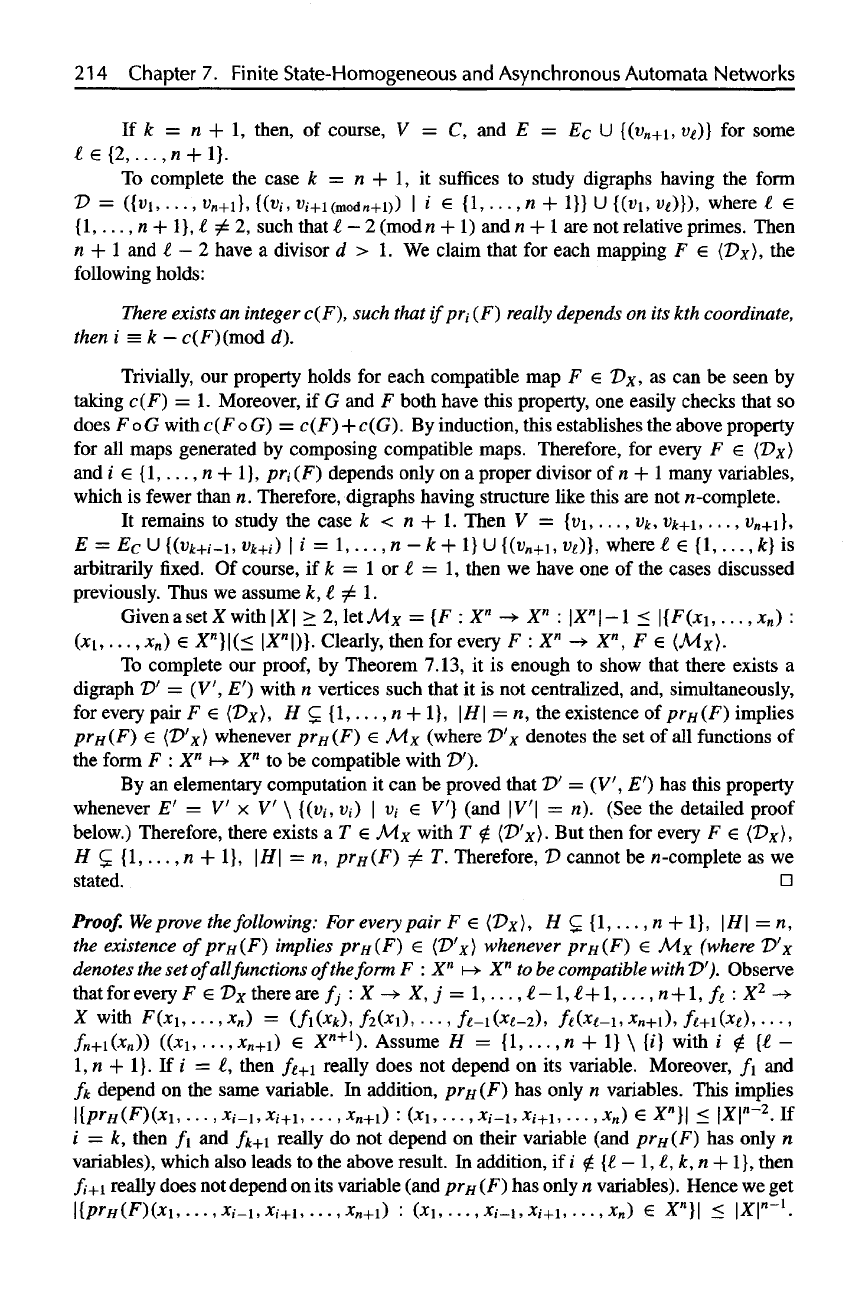
214
Chapter
7.
Finite State-Homogeneous
and
Asynchronous Automata Networks
If
k = n + 1,
then,
of
course,
V = C, and E = EC U
{(v
n+1
,
v
e
)}
for
some
£€{2,...,
n + l}.
To
complete
the
case
k = n + 1, it
suffices
to
study digraphs having
the
form
X>
=
({vi,...,
v
n+i
},
{(V
i
,
v
i
+Kmodn+i))
'
{1,...,
n + 1}} U
{(v
i
,
v
e
)}), where
t e
{1,...,
n + 1), t 2,
such that
l
—
2
(modn
+ 1) and n + 1 are not
relative primes. Then
n
+ 1 and t — 2
have
a
divisor
d > 1. We
claim that
for
each mapping
F e
(D
x
),
the
following
holds:
There
exists
an
integer
c(F), such
that
if
pr
i
(F)
really
depends
on its kth
coordinate,
then
i k-
c(F)(mod
d).
Trivially,
our
property holds
for
each compatible
map F e
T>x,
as can be
seen
by
taking
c(F)
= 1.
Moreover,
if G and F
both have this property,
one
easily checks that
so
does
F o G
with
c(F o G) =
c(F)
+
c(G).
By
induction, this establishes
the
above property
for
all
maps generated
by
composing compatible maps. Therefore,
for
every
F e
(Dx)
and
i e
{1,...,
n + 1}, pr
t
(F)
depends only
on a
proper divisor
of n + 1
many variables,
which
is
fewer
than
n.
Therefore, digraphs having structure like this
are not
n-complete.
It
remains
to
study
the
case
k < n + 1.
Then
V =
{vi,...
,Vk,
Vk+i,...,
v
n+
i},
E
=
E
C
\J
{(v
k+
i-i,
v
k+i
)
\i =
l,...,n-k+l}U
{(v
n+1
,
u/)}, where
t e
{1,...,
k} is
arbitrarily
fixed. Of
course,
if k = 1 or t = 1,
then
we
have
one of the
cases discussed
previously.
Thus
we
assume
k, t ^ 1.
Given
a set X
with
X
>2,letM
x
= {F : X
n
-> X" : X -l <
\{F(xi,...,x
n
)
:
(*!,...,*„)€
X
n
} (< X" )}.
Clearly, then
for
every
F : X
n
-> X", F e
(M
x
).
To
complete
our
proof,
by
Theorem 7.13,
it is
enough
to
show that there exists
a
digraph
V = (V, E')
with
n
vertices such that
it is not
centralized, and, simultaneously,
for
every pair
F e
(D
x
),
H
{1,...,
n + 1}, H = n, the
existence
of
pr
H
(F)
implies
prn(F)
e
(D'
x
) whenever
pr
H
(F)
e MX
(where
D'
x
denotes
the set of all
functions
of
the
form
F : X
n
i-» X" to be
compatible with
V).
By
an
elementary computation
it can be
proved that
T>'
= (V, E') has
this property
whenever
E' = V x V \
{(v
t
,
v
r
) v
t
e V'}
(and
\V'\
= n).
(See
the
detailed proof
below.) Therefore, there exists
a T € M
x
with
T
(D'
x
}.
But
then
for
every
F
(D
x
],
H
C
{1,...,
n + 1}, H = n,
pr
H
(F)
T.
Therefore,
T>
cannot
be
n-complete
as we
stated.
Proof.
We
prove
the
following:
For
every
pair
F e
(D
x
),
H C.
{1,...,n
+ !}, \H\ = n,
the
existence
of
pr
H
(F)
implies
pra(F)
e
(D'x} whenever
pr
H
(F)
e M
x
(where
D
x
denotes
the set
of
all
functions
of
the
form
F : X
n
->- X
n
to be
compatible
with
D).
Observe
that
for
every
F e D
x
there
are f
j
: X -+ X, j =
1,...,
1-1,1
+
1,...,n
+1, f
t
: X
2
->
X
with
F(xi,... ,x
n
)
=
(f
1
(x
k
),
f
2
(x
1
),...,
ft-1(x
t
-2)
t
ft(x
t
-i,
x
n
+i),
ft+\(x
t
),...,
f
n+
i(x
n
»
((xi,...,
JC.+1)
X
n+l
).
Assume
H =
{I,...,
n + 1} \ {/}
with
i t (I-
1,
n + 1}. If i = t,
then
/^
+
i
really does
not
depend
on its
variable. Moreover,
f\ and
fk
depend
on the
same variable.
In
addition,
prjj
(F) has
only
n
variables. This implies
\{pr
H
(F)(x
l
,...,x
i
-i,x
i+l
,...,x
H+l
):(xi,...
t
x
i
-i,x
i+l
,...,x
n
)eX
n
}
< X
n
~
2
.
If
/
= k,
then
/i and
fk
+
\
really
do not
depend
on
their variable (and
pr
H
(F) has
only
n
variables), which also leads
to the
above result.
In
addition,
ifi£{t
—
l,l,k,n
+ l},
then
fi+i
really does
not
depend
on its
variable (and
pr
H
(F)
has
only
n
variables). Hence
we get
\{pr
H
(F)(xi,...,Xi-i,x
i+
i,...,x
n+i
)
:
(x
i
,...
,*«_i,
x
i+
i,...,
x
n
)
X
n
}\
< X
n
-
1
.
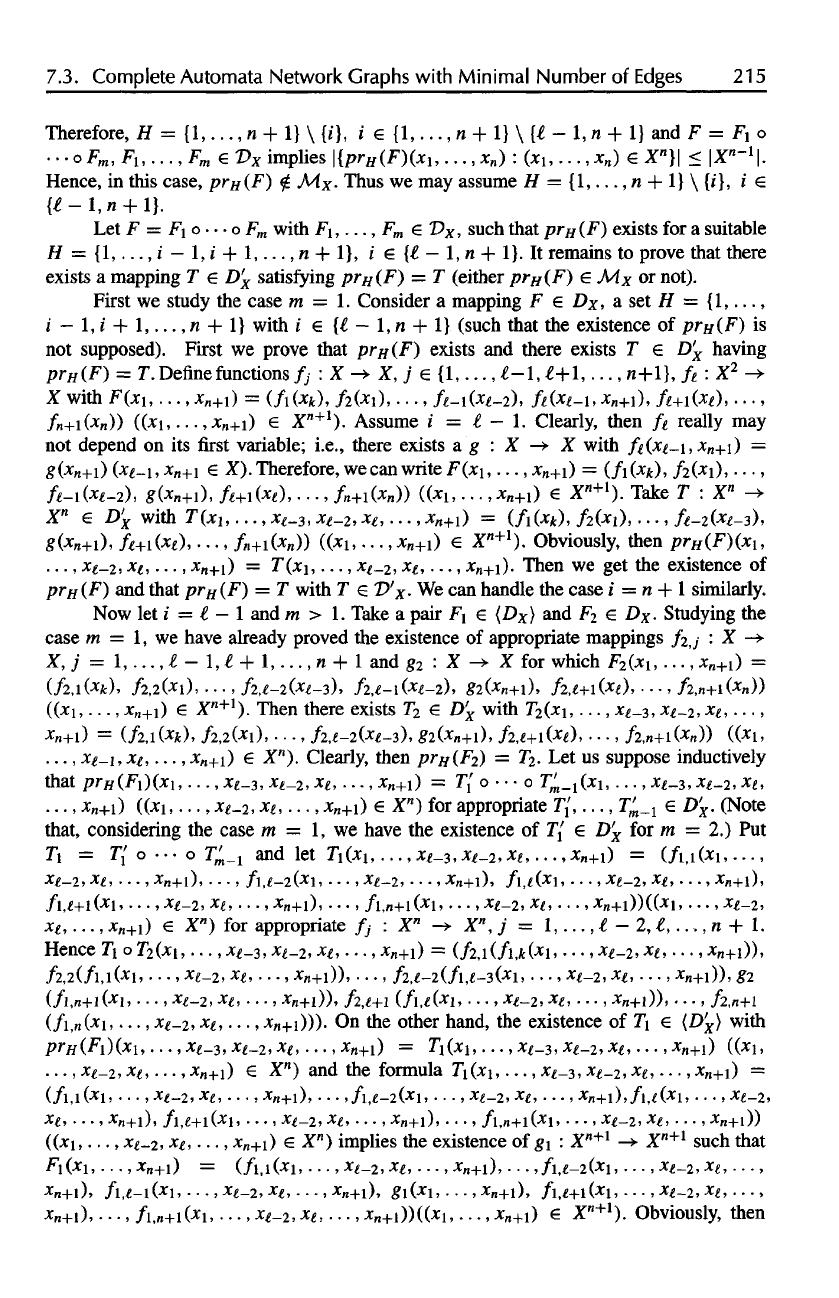
7.3. Complete Automata Network
Graphs
with Minimal Number
of
Edges
215
Therefore,
H =
{1,...,
n + 1} \
[i],
i e
{1,...,
n + 1} \ (t - 1, n + 1} and F = F
l
o
...
oF
m
,F
l
,...,F
m
eV
x
implies
\{pr
H
(F)(x
1
,...,x
m
):(xi,...,x
n
)
e X
n
}
X
n-1
\.
Hence,
in
this case, /?r#
(F) £ MX-
Thus
we may
assume
H =
[I,...,
n + 1} \
{/},
i e
{£-l,n
+ l}.
Let F = FI o • • • o F
m
with
F\, . . . , F
m
eT)
x
, such that
pr
H
(F)
exists
for a
suitable
H
=
{I,...,
i — 1, i +
1,...,
n + 1}, i e {t — 1, n + 1}. It
remains
to
prove that there
exists
a
mapping
T e D'
x
satisfying pru(F}
= T
(either
pr
H
(F)
e MX or
not).
First
we
study
the
case
m = 1.
Consider
a
mapping
F € DX, a set /f =
{!,...,
i — 1, i +
1,...,
n + 1}
with
i e {£
—
1, n + 1}
(such that
the
existence
of
pr
H
(F)
is
not
supposed). First
we
prove that
prjj(F)
exists
and
there exists
T e D'
x
having
pr
H
(F)
= T.
Define
functions/,
: X -+ X, j e
{1,...,
t-\,
t+\,...,
n+1},
ft : X
2
->
X
with F(XI,
...,
x
n+
i)
=
(fi(x
k
),
/
2
(*i),...,
fi-i(xt-2),
ft(xt-i,
x
n
+i),
fi+i(xi),...,
f
n
+i(x
n
))
((xi,...,
x
n
+\)
e
X
n+l
}.
Assume
i = t — 1.
Clearly, then
ft
really
may
not
depend
on its first
variable; i.e., there exists
a g : X
—>
X
with
ft(xt-i,x
n+
\)
=
g(x
n+
i)
(xt-i,x
n
+i
€
X).Therefore, wecan write
F(XI,
...,
x
n
+i)
=
(fi(x
k
),
f
2
(xi),...,
ft-i(xt-
2
),
g(x
n+
i),
ft+i(xt),...,
/»+I(JC
B
))
<(jc
lf
...,
x
n+l
)
e
X
n+1
).
Take
T : X
n
-»
X
n
6 D'
x
vrHhT(xi,...,x
t
-3,xi-2,xi,...,x
n
+i)
=
(f\(x
k
),
/
2
(*i),...,
ft-
2
(xt-i),
gU
B+
i),
/£+i(^),...,
/
B
+i(^«)) ((*i,
• • •,
^n+i)
e
X
n+1
).
Obviously, then
pr
H
(F)(xi,
..., Xi-2,
Xi,...,
x
n+
i)
=
T(XI,
...,
;t£_
2
,
Xi,...,
x
n+
i).
Then
we get the
existence
of
pr
H
(F)
and
that
pr
H
(F)
— T
with
T e
D'x-
We can
handle
the
case
i = n + 1
similarly.
Now
let i = t — 1 and m > \.
Take
a
pair
FI €
(D*)
and F
2
€
£>x-
Studying
the
case
m = 1, we
have already proved
the
existence
of
appropriate mappings
/2j : X ->
X,
j =
1,...,
t - 1, t +
1,...,
n + 1 and g
2
: X -> X
for
which
F
2
(*i,...,
*
B+
i)
=
(/2.lUjfc)»
/2,2(^l),
••-,
/2,£-2(^-3),
/2,£-l(^£-2),
g2(^n+l),
/
2
,*+l(**),•••,/
2
,n+l(*n))
((jci,...,
jc
n+
i)
e
X
n+1
).
Then there exists
r
2
e
Z)^-
with
r
2
(^i,...,
xi-$, xe-
2
,
x
t
,...,
Xn+l)
=
(f2,l(Xk),
/2,2(Xi),
. . . ,
/
2>
/-
2
(^-3),
ft(^n+l),
/
2
,M-lfo),
• • • »
/2,n+lU«»
((^1>
..., jc^-i,
jc£,...,
Jc
n+
i)
€
X"). Clearly, then
pr
w
(F
2
)
= T
2
. Let us
suppose inductively
that
pr
H
(F\}(x\,...,
*£_
3
, ^_
2
,
x
f
,...,
x
n+
i)
= T{ o • • • o
I^fo,...,
^_
3
, ^_
2
,
^,
...,
JC
B+I
)
((xi,..., x
t
-2,
XL,...,
x
n+
i)
€ X
n
} for
appropriate T/,...,
T^ e
D'
x
. (Note
that, considering
the
case
m = 1, we
have
the
existence
of T[ € D^ for m = 2.) Put
TI
= T{ o
•••
o
r^_
:
and let
TI^I,
...
,xt-
3
,xt-
2
,xt,
- - -
,x
n+
i)
=
(fi,i(xi,...,
Xi-2,
Xt,...,
X
n
+i),
. . . ,
fi,t-2(Xi,
• • • ,
Xt-2, ..-,
X
n+1
),
fi
t
t(Xi,
...,
Xi-2,
XL,...,
X
n
+l),
fl,l+l(Xi,
...,Xi-
2t
X
t
, ...,X
n+i
),
...,/!,„+!
(Xi,
...,Xt-2,Xt,...,X
n+
i))((Xi,
. . . ,
X
t
-2,
Xi,...,
JC
B+
I)
e X
n
) for
appropriate
/
;
: X
n
-> X
n
, j = 1,
...,t-
2,
i,..,,
n + 1.
Hence
TI o
T
2
(x\,...,
**_
3
, ^_
2
,
^,...,
JC
H+
I)
=
(/
2
,i(/uUi,
• • •,
^-2,
, • • •,
*B+I)),
/2,2(/l,l(^l,
• • • ,
Xi-2,
Xt,...,
Jf«+l)),
• . . ,
/
2>
/-
2
(/M-3(*l,
• • • .
^-2,
^, • • • ,
JCn+l)),
^2
(/l,n+lC*l>
• • • »
Xi-2,
Xt, . . .,
X
n+
i)),
/2,t+l
(fl,l(xi,
• • • ,
Xi-2,
Xt, • • • ,
*n+l))»
• • • »
/2,n+l
(fi,n(xi,
• • •,
JC£-2»
^, • • •,
^n+i)))-
On the
other hand,
the
existence
of TI €
(D'
x
) with
prH(Fl)(Xl,...,Xt-3,Xt-2,Xt,...,X
n+
i)
=
Ti(Xi,...,Xt-3,Xt-2,Xt,...,X
n+
i)
((*i,
..., xt-2,
xt,...,
x
n
+i)
e X") and the
formula
T\(x\,...,
^_
3
, */_
2
,
x/,...,
x
n+1
)
=
(/l,l(-^l>
• • •
,-*€-2»^»
• • •
»*«+l)»
• • •
»/l,£-2(^l.
• • •
,Xi-2,Xi,
. . .
,X
n
+i),fi
t
i(Xi,
. . . ,
Xt-2,
Xt,
•
••
,*n+l),
fl,t+l(Xi,
. . .
,Xt-2,Xt,
. . .
,X
n+
i),
...,
fl,
n
+l(x\,
. . . ,
Xi-2,
Xi, • • • ,
*n+l))
((*i,...,
xt-2,
xt,...,
x
n
+i)
e X")
implies
the
existence
of gi :
X
n+l
->•
X
n+l
such that
FI(XI,
. . .
,X
n+
i)
=
(/l,l(Xl,
. . .
,Xt-2,Xt,
. . .
,X
n+
i),
. . .
,fl,t-2(Xl,
. . .
,Xt-2,Xt,
. . . ,
X
n
+l),
fl,t-l
(Xl,
...
,Xt-2,Xt,
...
,X
n+
i),
gi(x\,
. ..
,X
n+
i),
fi
t
t+l(Xi,
...
,Xt-2,Xt,
. . . ,
x
n+
i),...,
fi,
n
+i(xi,...,
xt-2,
xt,...,
x
n
+i))((xi,...,
x
n+l
)
e
X"
+1
).
Obviously, then
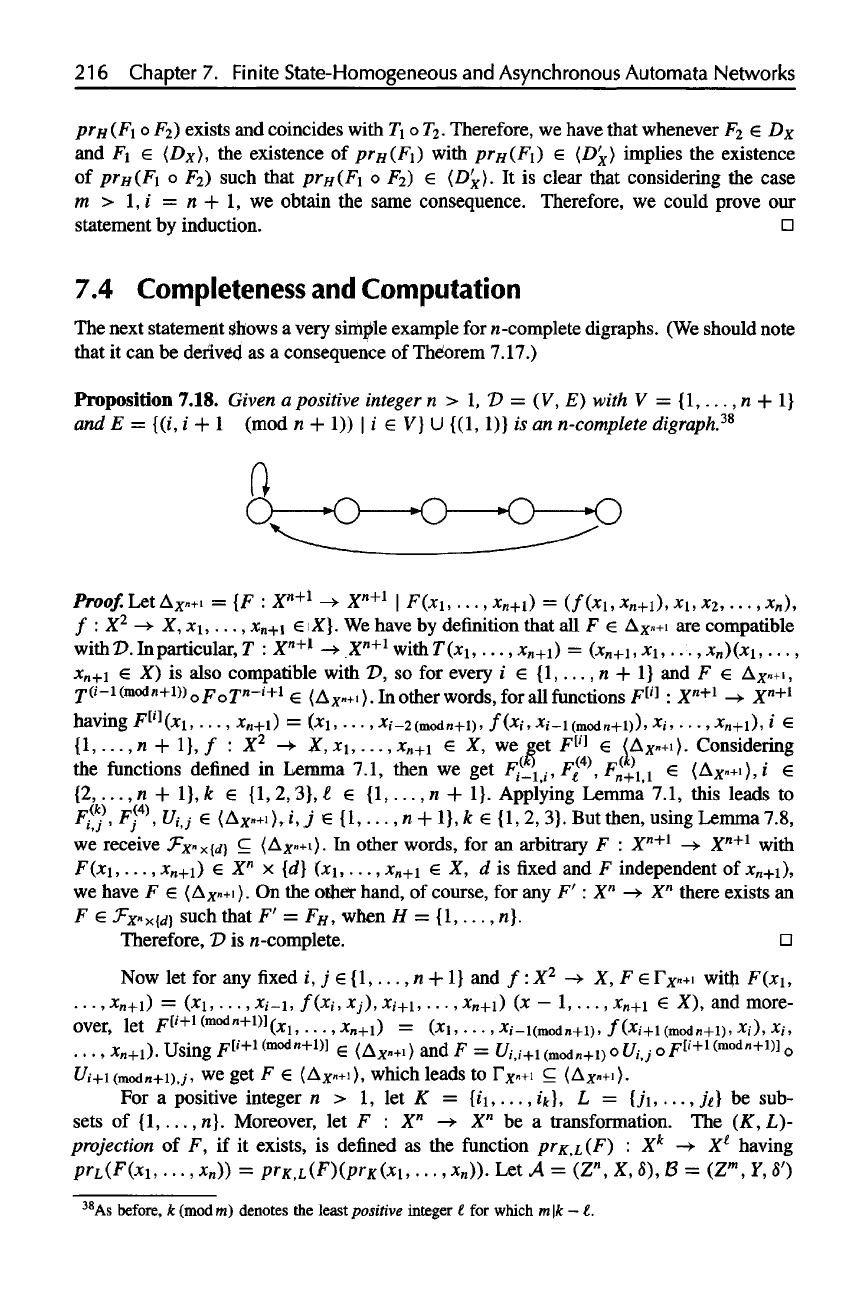
216
Chapter
7.
Finite
State-Homogeneous
and
Asynchronous
Automata Networks
P?H
(F\ o ¥2)
exists
and
coincides with T\oT2. Therefore,
we
have that whenever
FI e DX
and FI e
(D
x
),
the
existence
of
pr
H
(F\)
with
pr
H
(F\)
<E
(D'
x
} implies
the
existence
of
prji(F\
o F2)
such that
prH(F\
o Fj) e
(D'
x
).
It is
clear that considering
the
case
m
> l,i = n + 1, we
obtain
the
same consequence. Therefore,
we
could prove
our
statement
by
induction.
7.4
Completeness
and
Computation
The
next statement Shows
a
very simple example
for
n-complete digraphs.
(We
should note
that
it can be
derived
as a
consequence
of
Thdorem 7.17.)
Proposition
7.18.
Given
a
positive
integer
n > 1, V = (V, E)
with
V =
{1,...,
n + 1}
and
E =
{(i,
i + 1
(mod
n + 1)) | i e V} U
{(1,
1)} is an
n-complete
digraph?*
JVoo/.LetA^.
= {F :
X
n+l
-+
X
n+l
\
F(
Xl
,...
,x
n+1
)
=
(/(*i,*
n+
i),*i,*2,
...,*„),
f
: X
2
->• X,
xi,...,
x
n
+i
€ X}. We
have
by
definition that
all F e
A
x
«+i
are
compatible
with
T>.
In
particular,
T :
X
n+l
->
X
n+l
with
T(XI,
...,
*
n
+i)
=
(x
n
+i,
xi,...,
*„)(*!,...,
x
n+
\
€ X) is
also compatible with
Z>,
so for
every
i e
{1,...,
n + 1} and F e
AX«+I,
r
(i-Kmodn+i))
oFor
«-i+i
€
(A
xn+1
).
In
other words,
for
all
functions
F
[I]
:
X
n+1
->
X
n+l
having F
ll]
(Xi,
...,
X
n
+i)
=
(X\,
...,
X,-_2(modn+l),
f(*i,
*i-l(modn+l)),
*i>
•••,
X
n+
i),
I €
{!,...,n
+I},/
: X
2
->
X,xi,...,x
n
+i
e X, we get
F
1
''
1
€
{A
x
»+i}.
Considering
the
functions
defined
in
Lemma
7.1,
then
we get
Ff_
lf
,
F^
4
\
F^ j €
(Ax»+i),*'
€
{2,...,
n + 1}, k e
[1,2,3},
t €
{!,...,«
+ 1}.
Applying Lemma
7.1,
this leads
to
F$, Ff\
Ufj
e
(A
xn+
i),
i, j e
{1,...,
n + 1}, k e {1, 2, 3}. But
then, using Lemma 7.8,
we
receive
^x"x{d}
^
{A*«+i).
In
other words,
for an
arbitrary
F :
X
n+l
->
X
n+1
with
F(XI,
...,
x
n+
\)
£ X
n
x {d}
(xi,...,
x
n+
i
e X, d is fixed and F
independent
of
*
n
+i),
we
have
F e
{A^»+i
>.
On the
oihet
hand,
of
course,
for any F': X
n
-> X
n
there exists
an
F
e
Fx*x(d]
such that
F' = F
H
,
when
/f =
{1,...,
n}.
Therefore,
D is
n-complete.
Now
let for any fixed i, j e {1, . . . , n + 1} and / : X
2
-> X, F €
r
xn+
i
with.
. . . ,
*
n+1
)
=
(*!,...,
x,-_i,
f(x
it
Xj),
x
i+
i,
...,
Xn+i)
(x
-I,...,
x
n+
i
€ X), and
more-
over,
let
F
[/+1(modn
+
1)]
(*i,...,X
n+
i)
=
(Xi,...,X
|
-_i
(mo
dn
+
l),/(^+l(modn+l),^),^,
. . . ,
X
B+
I).
Using
F»
+1
(modn+1)]
e
<
A
xn+
,
) and F =
£/
w+1
(modn+1)
o t/
w
o F^
1
<
mod
"
+1
>]
o
Ui+i(nodn+i).j,
we get F e
(A
x
«+i),
which leads
to
T^+i
c
(A
x
«+i).
For
a
positive integer
n > 1, let K =
{/i,
. . . , 4), L =
{y'i,
. . . , je] be
sub-
sets
of
{!,...,
n}.
Moreover,
let F : X
n
> X
M
be a
transformation.
The (K, L)-
projection
of F, if it
exists,
is
defined
as the
function
pr
K<L
(F)
: X
k
-*• X
1
having
pr
L
(F(xi,
...,
x
n
))
=
pr
K
,
L
(F)(pr
K
(
Xl
,
...,
x
n
)).
Let A =
\Z
n
,
X, 5), B =
(Z
m
,
Y,
8
f
)
8
As
before,
k
(modm)
denotes
the
least
positive
integer
I for
which
m\k
—
(..
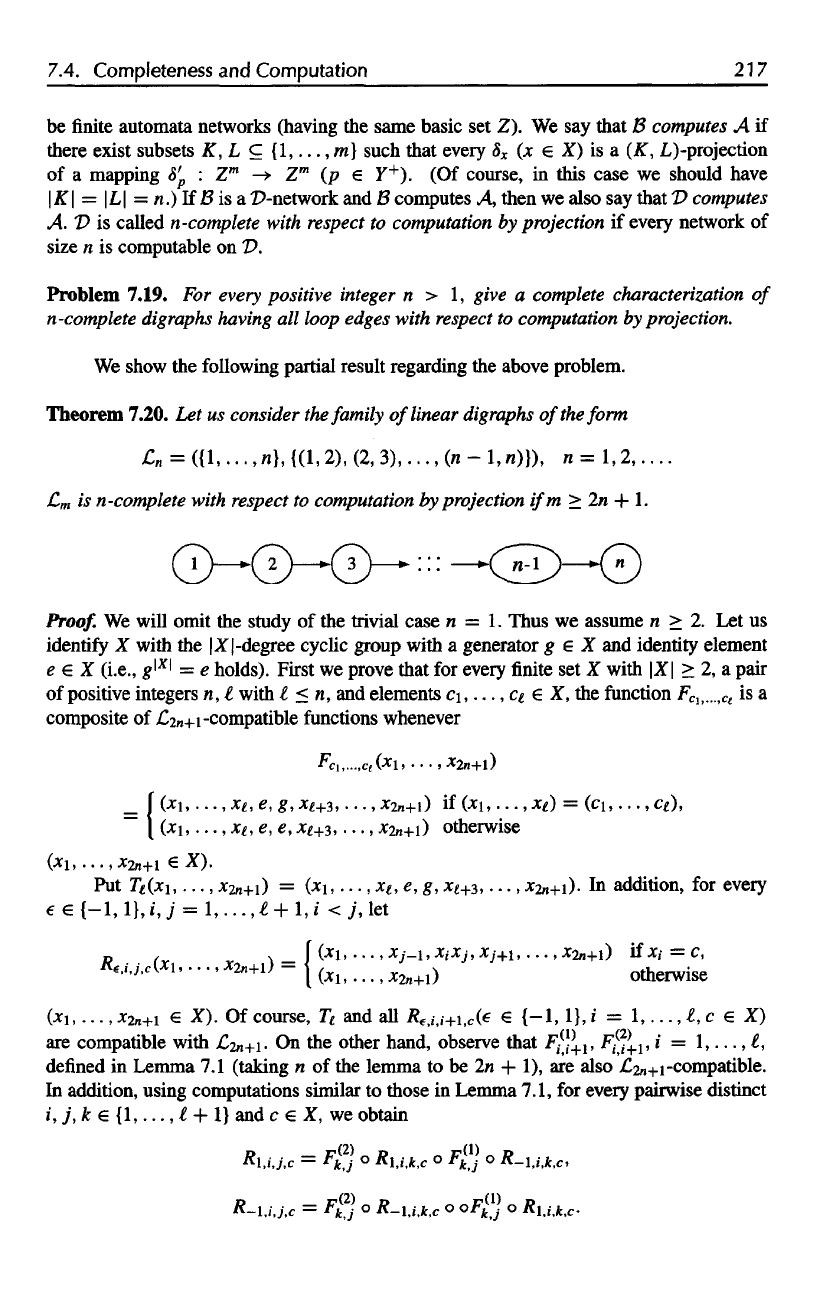
7.4. Completeness
and
Computation
217
be finite
automata networks (having
the
same basic
set Z). We say
that
B
computes
A if
there exist subsets
{1,...,
m}
such that every
(x e X) is a (K,
L)-projection
of
a
mapping
: Z
m
-> Z
m
(p e
Y
+
).
(Of
course,
in
this case
we
should have
If
B is a
D-network
and B
computes
A,
then
we
also
say
that
D
computes
A. D is
called n-complete with
respect
to
computation
by
projection
if
every network
of
size
n is
computable
on D.
Problem
7.19.
For
every
positive
integer
n > 1,
give
a
complete
characterization
of
n-complete
digraphs
having
all
loop
edges
with
respect
to
computation
by
projection.
We
show
the
following partial result regarding
the
above problem.
Theorem
7.20.
Let us
consider
the
family
of
linear
digraphs
of
the
form
C
m
is
n-complete with
respect
to
computation
by
projection
if
m > 2n + 1.
Proof.
We
will omit
the
study
of the
trivial case
n = 1.
Thus
we
assume
n > 2. Let us
identify
X
with
the
-degree
cyclic
group with
a
generator
g e X and
identity element
e
e X
(i.e.,
= e
holds). First
we
prove that
for
every
finite set X
with
, a
pair
of
positive integers
n, I
with
t < n, and
elements
c
1
,...,
c
l
G X, the
function
F
Clt
...,
Ct
is a
composite
of
L
2n+1
-compatible functions whenever
Fc
1
,...,c
t
(X
l
,...,X
2n+l
)
Put
TI(XI,
...,
x
2n+1
)
=
(x
1
,
• • •, x
e
, e, g,
x
i+3
,...,
x
2n+i
)-
In
addition,
tor
every
€
e
{-1,1},
i, j = 1,
...,l
+ 1, i < ;, let
(x
1
,...,
x
2n+1
€ X). Of
course,
T
e
and all i = 1,
...,l,
c e X)
are
compatible with
L
2n+1
• On the
other hand, observe that
,
defined
in
Lemma
7.1
(taking
n of the
lemma
to be 2n + 1), are
also
£
2n+1
-compatible.
In
addition, using computations similar
to
those
in
Lemma 7.1,
for
every pairwise distinct
i, j, k € (1,
...,t
+ 1} and c e X, we
obtain
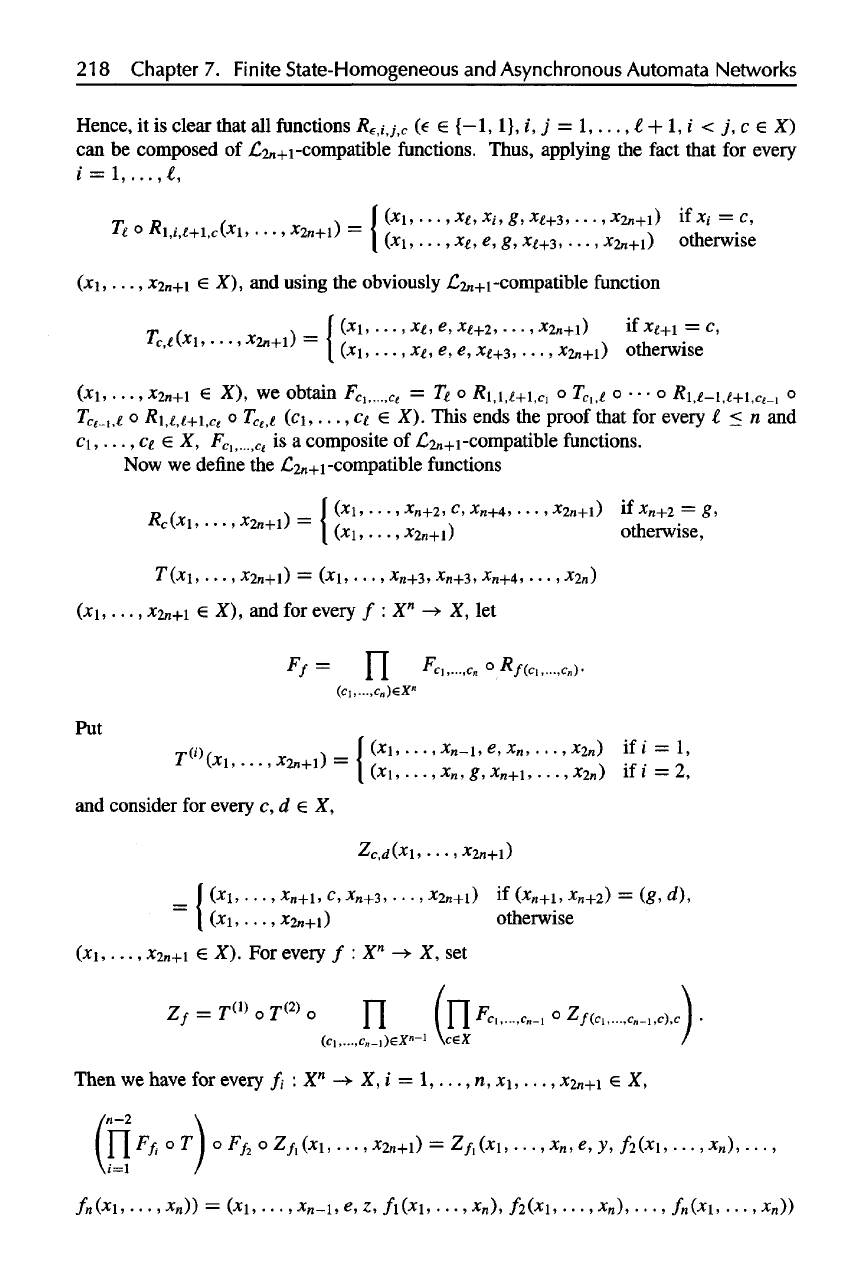
218
Chapter
7.
Finite State-Homogeneous
and
Asynchronous
Automata Networks
Hence,
it is
clear
that
all
functions
R
e
,
ij,c
(
{—1»
1},i,
j =
1,..
., + l,i < j, c X)
can
be
composed
of
2n+1
-compatible functions. Thus, applying
the
fact
that
for
every
i
=
1,...,€,
and
using
the
obviously
£2/1+1
-compatible function
..., x
2n+
i
€ X), we
obtain
F
Cl
,...
)Q
= TI o
/?i,i^+i
)Cl
o
T
c
\,t
o • • • o
RI,1-1,1+1,0^
°
i,£
°
fli,£,M-i,c
€
°
7^,* (A,...,
Q € X).
This ends
the
proof that
for
every
i < n and
,..,
Q e X,
F
CI>
...
)Q
is a
composite
of
£2^+1
-compatible functions.
Now
we
define
the
£,
2n
+\
-compatible functions
T(X
1
,
. . . ,
x
2n
+l)
= (x
1
• • •
-X
n+3
,
x
n+3
,
x
n
+4,
• • • ,
x
2n
)
(x
1
,...,
X
2n+1
€ X), and for
every
f : X
n
-> X, let
Put
and
consider
for
every
c,d e X,
(x
1
,...,
x
2n+1
€ X). For
every
f : X
n
-> X, set
Then
we
have
for
every
f
i
: X
n
-> X, i =
1,...,
n,
x
1
,...,
X
2n+1
e X,
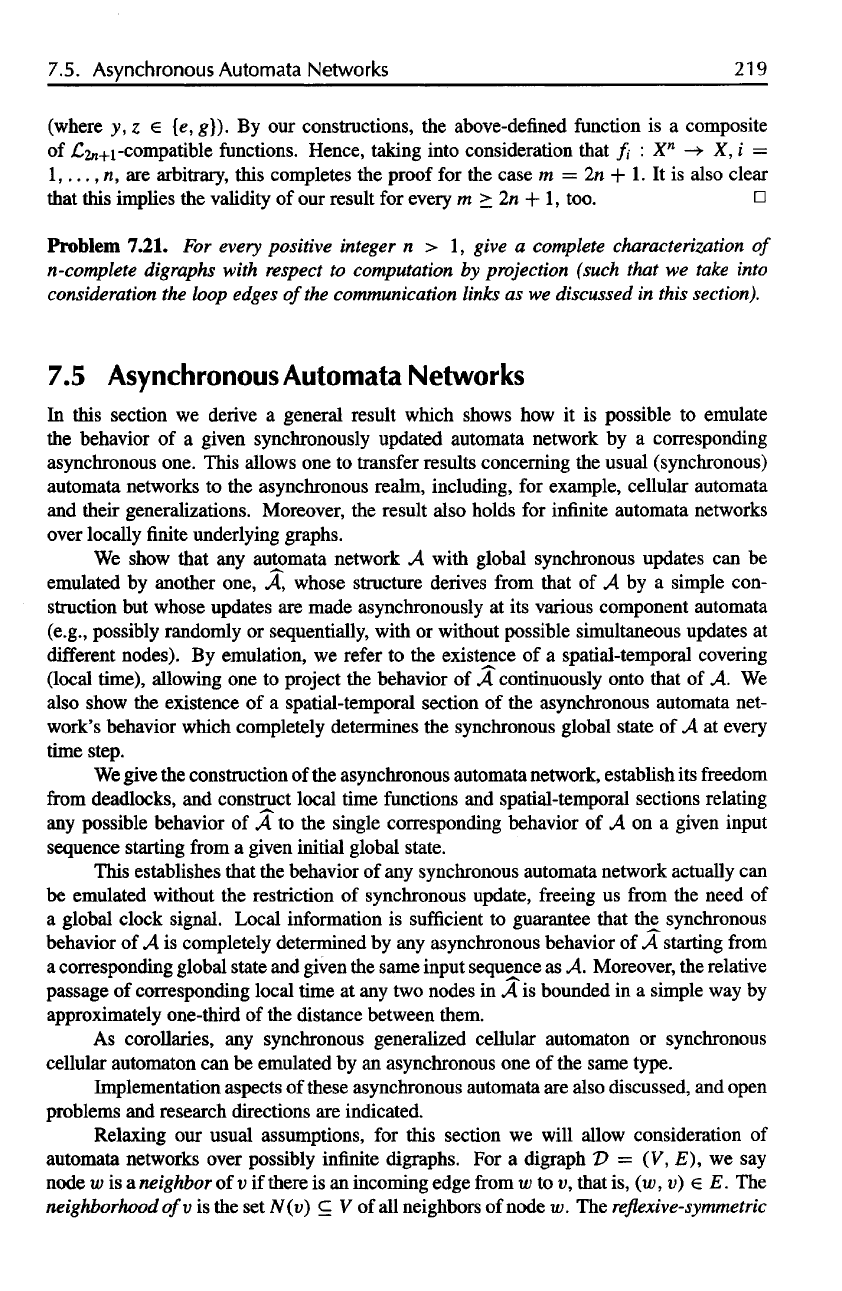
7.5.
Asynchronous
Automata Networks
219
(where
y, z € {e,
g}).
By our
constructions,
the
above-defined
function
is a
composite
of
£2«+i
-compatible
functions.
Hence, taking into consideration that
ft : X
n
-» X, i =
!,...,«,
are
arbitrary, this
completes
the
proof
for the
case
m = 2n + 1. It is
also
clear
that this implies
the
validity
of our
result
for
every
m > 2n + 1,
too.
Problem 7.21.
For
every
positive
integer
n > 1,
give
a
complete
characterization
of
n-complete
digraphs
with
respect
to
computation
by
projection
(such
that
we
take
into
consideration
the
loop
edges
of
the
communication
links
as we
discussed
in
this
section).
7.5
Asynchronous
Automata Networks
In
this
section
we
derive
a
general
result
which shows
how it is
possible
to
emulate
the
behavior
of a
given synchronously updated automata network
by a
corresponding
asynchronous one. This allows
one to
transfer results concerning
the
usual (synchronous)
automata networks
to the
asynchronous realm, including,
for
example, cellular automata
and
their generalizations. Moreover,
the
result also holds
for
infinite
automata networks
over
locally
finite
underlying graphs.
We
show that
any
automata network
A
with global synchronous updates
can be
emulated
by
another one,
A,
whose structure derives
from
that
of A by a
simple con-
struction
but
whose updates
are
made asynchronously
at its
various component automata
(e.g., possibly randomly
or
sequentially, with
or
without possible simultaneous updates
at
different
nodes).
By
emulation,
we
refer
to the
existence
of a
spatial-temporal
covering
(local
time),
allowing
one to
project
the
behavior
of A
continuously onto that
of A. We
also show
the
existence
of a
spatial-temporal section
of the
asynchronous automata net-
work's behavior which completely determines
the
synchronous global state
of A at
every
time step.
We
give
the
construction
of the
asynchronous automata network, establish
its
freedom
from
deadlocks,
and
construct
local
time
functions
and
spatial-temporal sections relating
any
possible
behavior
of A to the
single corresponding behavior
of A on a
given input
sequence starting
from
a
given initial global state.
This establishes that
the
behavior
of any
synchronous automata network actually
can
be
emulated without
the
restriction
of
synchronous update, freeing
us
from
the
need
of
a
global clock signal. Local information
is
sufficient
to
guarantee that
the
synchronous
behavior
of A is
completely determined
by any
asynchronous behavior
of A
starting
from
a
corresponding global state
and
given
the
same input sequence
as A.
Moreover,
the
relative
passage
of
corresponding local
time at any two
nodes
in A is
bounded
in a
simple
way by
approximately one-third
of the
distance
between them.
As
corollaries,
any
synchronous generalized cellular automaton
or
synchronous
cellular automaton
can be
emulated
by an
asynchronous
one of the
same type.
Implementation aspects
of
these asynchronous automata
are
also discussed,
and
open
problems
and
research directions
are
indicated.
Relaxing
our
usual assumptions,
for
this section
we
will allow consideration
of
automata networks over possibly
infinite
digraphs.
For a
digraph
T>
= (V, E), we say
node
w is a
neighbor
of v if
there
is an
incoming edge
from
w to v,
that
is, (w, v) e E. The
neighborhood
of
v is the set
N(v)
c V of all
neighbors
of
node
w. The
reflexive-symmetric
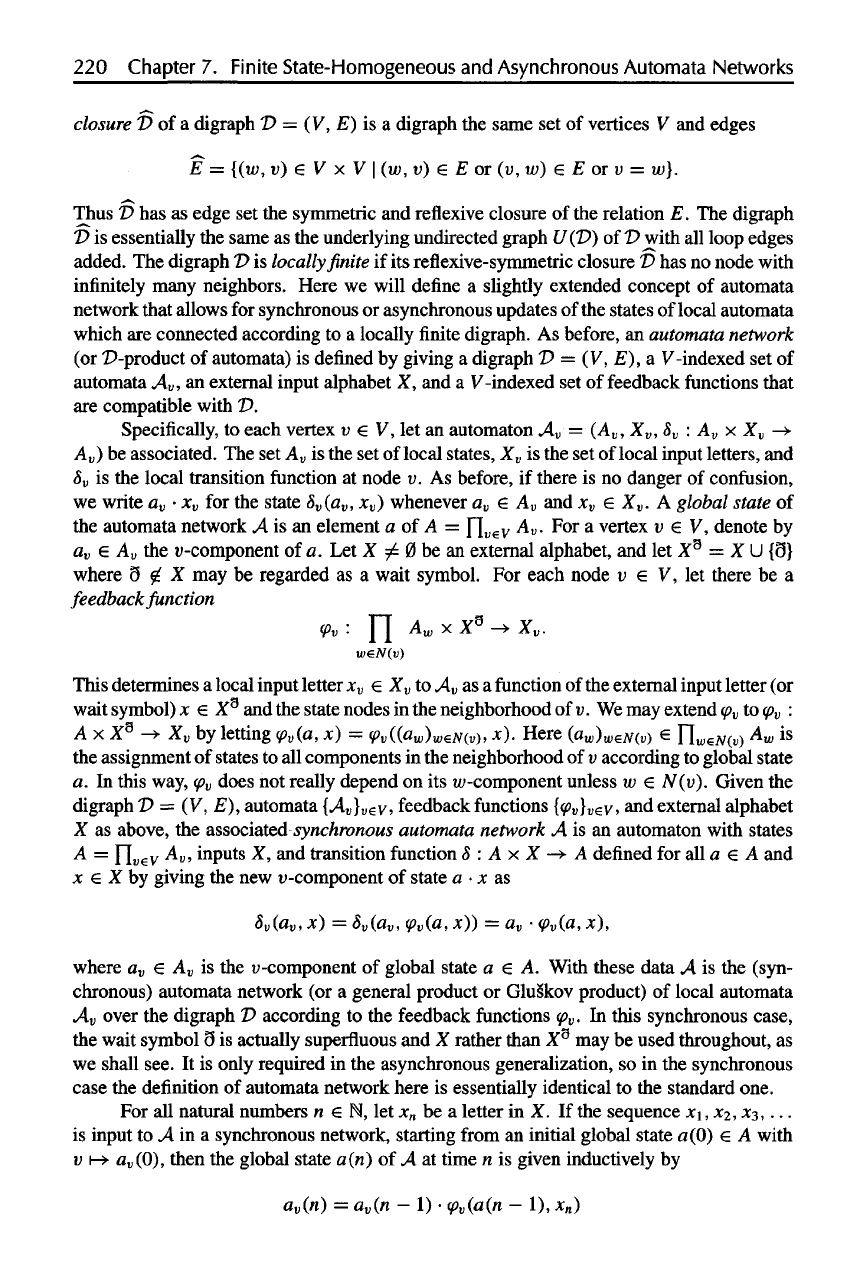
220
Chapter
7.
Finite
State-Homogeneous
and
Asynchronous
Automata Networks
closure
T>
of a
digraph
V = (V, E) is a
digraph
the
same
set of
vertices
V and
edges
Thus
£>
has as
edge
set the
symmetric
and
reflexive closure
of the
relation
E. The
digraph
T>
is
essentially
the
same
as the
underlying undirected graph
( ) of D
with
all
loop edges
added.
The
digraph
V is
locally
finite if its
reflexive-symmetric closure
has no
node with
infinitely
many neighbors. Here
we
will
define
a
slightly extended concept
of
automata
network that allows
for
synchronous
or
asynchronous updates
of the
states
of
local automata
which
are
connected according
to a
locally
finite
digraph.
As
before,
an
automata network
(or
P-product
of
automata)
is
defined
by
giving
a
digraph
D = (V, E), a
V
-indexed
set of
automata
A
v
, an
external input alphabet
X, and a V
-indexed
set of
feedback
functions
that
are
compatible with
D.
Specifically,
to
each vertex
v e V, let an
automaton
A
v
=
(A
v
,
X
V
,8
V
: A
v
x X
v
->
A,,)
be
associated.
The set A
v
is the set of
local states,
X
v
is the set of
local
input letters,
and
8
V
is the
local transition
function
at
node
v. As
before,
if
there
is no
danger
of
confusion,
we
write
a
v
• x
v
for the
state
8
v
(a
v
,
x
v
)
whenever
a
v
e A
v
and x
v
e X
v
. A
global state
of
the
automata network
A is an
element
a of A =
Y[
v€
y
AV For a
vertex
v e V,
denote
by
a
v
e A
v
the
u-component
of a. Let X ^ 0 be an
external alphabet,
and let X
s
= X U {9}
where
3 X may be
regarded
as a
wait symbol.
For
each node
v € V, let
there
be a
feedback
function
This determines
a
local
input letter
x
v
e X
v
to A
v
as a
function
of the
external input letter
(or
wait
symbol)
x e X
9
and the
state nodes
in the
neighborhood
of v. We may
extend
<p
v
to
<p
v
:
A
x
X®
->>
X
v
by
letting
^(a,
*) =
<p
v
((a
w
)
weN(V
),
x).
Here
(a
u
,)
u
,
e
^(
W
)
e
Owe^i;)
A
™
is
the
assignment
of
states
to all
components
in the
neighborhood
of v
according
to
global state
a. In
this way,
<p
v
does
not
really depend
on its
w-component unless
w e
N(v). Given
the
digraph
T>
= (V, E),
automata
{A
v
}
v
ev,
feedback functions
[<p
v
}vzv,
and
external alphabet
X
as
above,
the
associated synchronous automata network
A is an
automaton with states
A
=
Y[
V
€V
^«"
m
P
uts
-^ and
transition
function
5 : A x X -» A
defined
for all a e A and
x e X by
giving
the new
u-component
of
state
a • x as
where
a
v
e A
v
is the
u-component
of
global state
a 6 A.
With these data
A is the
(syn-
chronous) automata network
(or a
general product
or
Gluskov product)
of
local automata
A
v
over
the
digraph
Z>
according
to the
feedback functions
p
v
. In
this synchronous case,
the
wait symbol
5 is
actually superfluous
and X
rather than
X
9
may be
used throughout,
as
we
shall see.
It is
only required
in the
asynchronous generalization,
so in the
synchronous
case
the
definition
of
automata network here
is
essentially identical
to the
standard one.
For
all
natural numbers
n e N, let x
n
be a
letter
in X. If the
sequence
x\,
x%,
x$,...
is
input
to A in a
synchronous network, starting
from
an
initial global state a(0)
e A
with
v
i->-
a
v
(0),
then
the
global state
a
(n)
of A at
time
n is
given inductively
by
